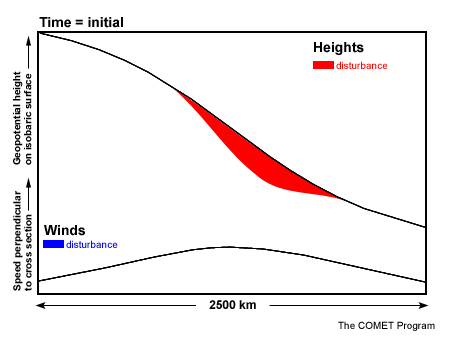

To start with, suppose the winds and heights are in perfect geostrophic balance when a disturbance is suddenly imposed upon it. The atmosphere responds by sending out gravity wave pulses, spreading out like ripples on a pond when a rock is dropped. In the wake of these gravity waves is left behind a new geostrophically balanced state. The new state is different from the original geostrophic conditions in both the winds and heights. These changes remain for a long time because the new state is balanced. This process of the atmosphere evolving toward a balanced state is called "geostrophic adjustment."
|
This schematic shows the sequence of events caused by suddenly imposing a height depression with no wind perturbation on a straight, geostrophically balanced, large-scale flow. The undisturbed geostrophic conditions are given by the black height and wind curves. The height (wind) perturbations associated with the disturbance at each time are shown with red (blue) shading. Disturbed states at the "initial" and "later" times are also overlayed on the "later" and "final" times for comparison. The spreading influence of the disturbance is heralded by the first wave propagating outward (the wave that has reached the furthest away from the disturbance center). Ahead of the wave, conditions remain undisturbed until the wave arrives, while conditions in the area where all the gravity waves have finished passing will have reached their final state. Eventually, smooth new geostrophically-balanced mass and wind fields result, with distant locations unaffected by the disturbance. The final state also would include inertial oscillations (like winds in the upper part of the boundary layer after nocturnal decoupling), but these are unimportant to the concepts and applications discussed here. |

|
The disturbance could be a convectively-generated vorticity maximum or a short wave or a cyclone that didn't appear in the model (or one in the model that doesn't appear in any observations). Or it could be whatever you want to partition off as "disturbance." For considering the influence of new data on the model forecast, the disturbance is the field of analysis increments resulting from that new data getting into the analysis.
In reality and in the model, the initial balanced state is not geostrophic; it includes curved flow, frontal circulations, jet streaks, and divergence associated with latent heating. Most of the time the mass and wind fields are closely coupled, slowly evolving in a "quasi-balanced" manner.
The changes to these balanced winds and heights are the response to the disturbance. For data assimilation, the response to the new data is the change in the forecast. The forecast includes the gravity wave ripples, but they go away early in the forecast period. If the disturbance grows gradually rather than being thrown in all at once, the gravity-wave part of the response is diminished but similar long-lived adjustments in the winds and heights will result.
Matters of greatest practical importance to determine are
![]()